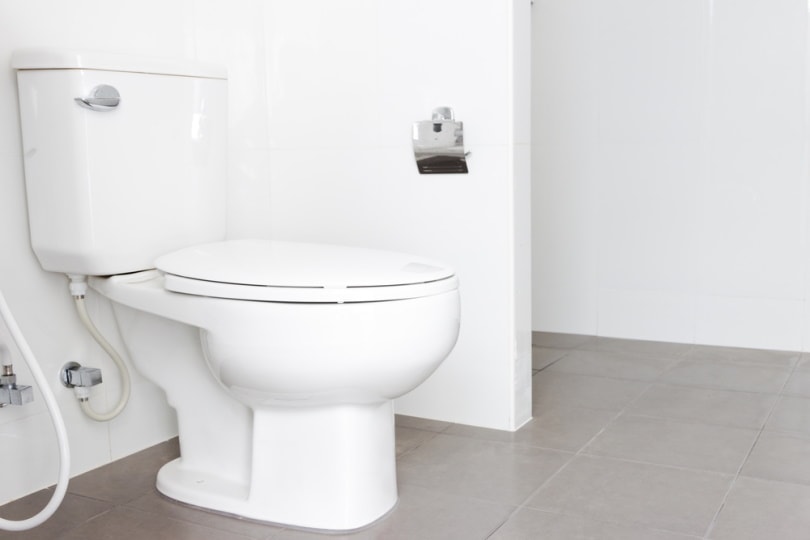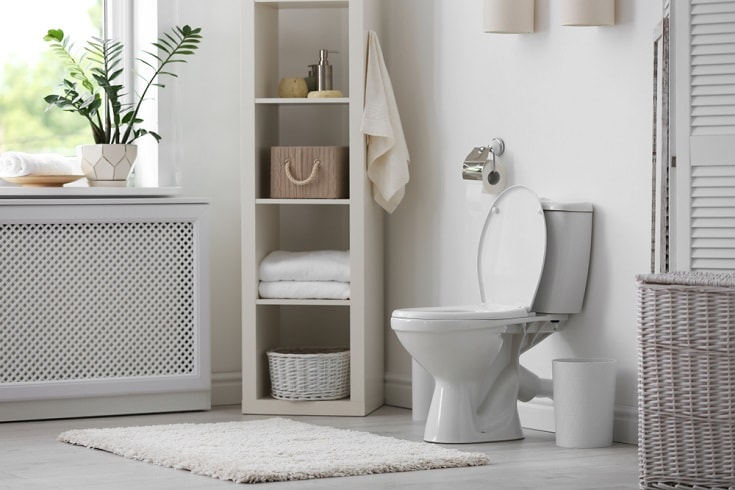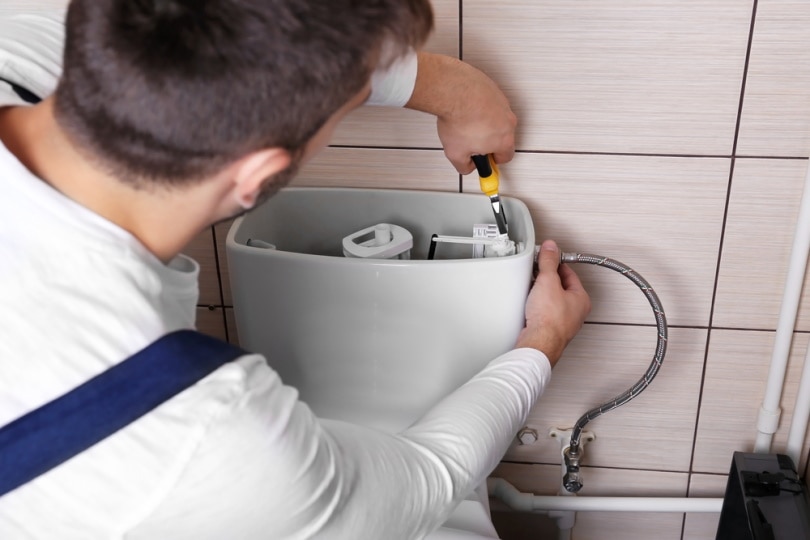How Does a Toilet Work? Step-by-Step Guide (With Pictures)
-

- Last updated:

Toilets are possibly the most utilized household fixtures, yet most people ignore the concept of their working. This simple engineering marvel, also known as the water closet, WC, or lavatory, is an essential part of everyone’s life. The toilet’s provenance can be traced back to 1596, when Sir John Harington invented the first flush toilet.¹
Despite the obvious value that toilets have in our lives, few people give much thought to how a flush toilet system works. So long as the toilet functions, most people may not bother themselves with the intricacies of a working toilet. Fortunately, toilet systems are not complicated. With a bit of time and effort, anyone can understand the basic workings of their home toilet.
Whether you want to have a deeper understanding of the inner workings of a toilet or simply want to indulge your mind out of sheer curiosity, this article has got you covered. We will look into how a toilet functions and the different types of toilets.2 We will also highlight common problems in toilets and their possible solutions. Scroll down to learn more.
How Does a Flush Toilet Work?
1. Pushing the Lever
After using the toilet, the first thing you do is press down the handle or push a button to activate the flush feature. On most standard models, the lever is usually located on the side of the tank/cistern. Newer toilet models are equipped with automatic sensors which require no handles at all.
Pushing the lever will not require a lot of effort; however, you have to wait for at least 10 seconds between flashes before pulling down the lever again. The reason for the delay is because lifting the flapper sets in motion a chain reaction inside the toilet tank.
2. Water Pours into the Bowl
Once the user activates the lever/button, a valve/flapper is lifted to open the water-flushing system. The flapper, also known as a flush valve, controls how much water moves from the tank into the bowl. Often made from flexible plastic or rubber, the flapper releases tank water into the bowl via rim jets and larger siphon jets.
Approximately two gallons of water move from the tank to the toilet bowl through gravitational pull. When the toilet tank empties, the fill valve is activated, and the flapper drops back into position, prohibiting water from flowing from the tank into the bowl. This allows the tank to refill with water for the next time Mother Nature calls.

3. Gravity Forces Water into a Trapway
As the water fills up the bowl, the weight of the water and gravitational pull encourage wastewater to flow out of the tank through a drain into the sewerage system. What happens is that the waste water is forced into a trap way which causes it to overflow at the top once it surpasses the tipping point on the “S shape”.
4. Water and Wastes Are Siphoned Out
When water flows over the top of the trapway, it creates suction which removes wastes and water from the toilet bowl. As the water is sucked from the bowl, air enters the trapway, which ends the siphoning effect and the flush. When all the wastewater is drained out, there should only be clean water left in the bowl.

5. The Tank Refills
After flushing, you should hear water refilling back into the toilet tank. This happens when the fill valve detects the absence of water in the tank and responds by filling it up from the water supply line. The water must reach the designated level required to flush the toilet when needed.
Common Problems Associated with Flush Toilets
No matter how well-designed toilets are, like most household fixtures, they will experience problems and breakages over time. With early detection and a bit of background information, you can easily sort out some of these issues before they limit the functionality of your toilet.
1. Low Water Level
Flush toilets typically have a certain amount of water in the tank and the bottom of the bowl. If the water levels go lower than the designated level, flushing issues may occur.
- The fill valve is not properly filling up the tank3
- The refill tube is not connected to the overflow tube, and the toilet bowl is cracked.
To solve these issues, you have to remove the toilet for further inspection to determine the appropriate course of action to take.

2. Toilet Leaking at the Base
When a toilet is leaking at the base, chances are that it is cracked or the toilet wax is not adhesive enough. When you flush, water will leak at the bottom of the toilet. To fix this, remove the toilet and replace the wax ring with a new wax ring or a rubber gasket seal. You can also seal cracks if it is damaged or buy another toilet if the damage is too extensive.

3. A Wobbly/Rickety Toilet
A toilet can be wobbly due to several factors, but the most likely culprit is the toilet flange.4 This is the foundation built to hold the toilet in place way above the floor and uneven floor. This problem often occurs when the bolts holding the toilet in place get loose or the wax ring has lost its stickiness due to time and use.
If you have plumbing experience, you can tighten any loose bolts. If the bolts are okay, you can use toilet shims to level the toilet. However, if the rickety toilet is leaking, you may have to replace the wax ring first before shimming the toilet. If you lack the necessary plumbing experience, consider contacting professional plumbers.

4. Toilet Won’t Stop Running
A toilet that won’t stop running usually points out to a defective flapper that doesn’t fit properly, a toilet fill valve, or an improperly positioned toilet float. Fortunately, the side parts are cheap and easily accessible at your local plumbing store, so you shouldn’t have a problem replacing them. Just make sure to turn off the water before you attempt any repairs.

5. Clogged Toilet
Toilets get clogged when one disposes of waste products like tampons that shouldn’t be flushed down a toilet. These waste products end up clogging the pipes leading to overflow issues.
To unclog a toilet, you can use a toilet auger or plunger. Alternatively, you could opt for a more DIY approach by using a wire hanger, dish soap and baking soda mixed with a vinegar solution.
If these solutions don’t work, you will ultimately have to remove the toilet for a more thorough inspection. Professional plumbers are best equipped to handle more serious clogging issues in your toilet.

Other Types of Toilets
Flush toilets may commercially retail in different shapes and sizes, but one thing they have in common is the relatively large and ugly waste disposal outlets. Also known as soil pipes, these outlets are so large and wide that they limit the space for the installation of standard toilets. Since most flush toilets work through the gravity-siphon effect, it’s quite impossible to install a bathroom in the middle of a building.
A possible solution to this problem is installing macerating toilets.
1. Macerating Toilets
These are also a great alternative if you want to install a toilet in a basement, yet the drain you want to flush into is above the toilet. Also known as up flush toilets, these types of toilets are a combination of the waste disposal unit and conventional toilets.
- With macerating toilets, the waste passes through some kind of a blender where it is mashed into a liquid form. It is then pumped through a thin pipe connected to the toilet. Electricity is used to power the macerator and the pump. This liquid waste product eventually goes to the large, main soil pipe through a thin pipe connected to the toilet.
- You can fit up the toilets almost anywhere in a building so long as there is water and electricity to pump the waste.
- They are cheaper than redoing the plumbing in your house for a conventional toilet in case of toilet issues.
- They can pump waste for a considerable distance. Typical macerating toilets can pump waste with an upward rise of 16 feet and a horizontal distance of 66 feet, or with an upward rise of 3.3 feet and a horizontal distance of 328 feet. This is more than enough distance for a typical home or commercial building.
- They’re more effective than the normal
- They are bigger and bulkier than conventional toilets.
- Macerators are noisier and less discreet when flushing.
2. Vacuum Toilets
One of the biggest drawbacks of standard flush toilets is the sheer amount of water they consume. Even the latest toilet models designed to be eco-friendly and efficient still waste over one US gallon of water per flush. This poses a real danger for public transport vehicles such as planes, trains, and long-distance buses, which have to ferry giant heavy water tanks for flushing.
This is why mobile public toilets now flush with air instead of water. This is the same concept used in vacuum toilets.
Granted, vacuum toilets sound like a far-fetched idea. But this concept will not be as strange if you remember that the conventional toilet flushes the waste down the drain but sucks it away through the siphoning effect. A vacuum toilet typically uses the same idea, but instead of using the dragging power of water, the sucking is created by low air pressure.
- When you flush a vacuum toilet, small amounts of water rinses out to partly fill the bowl, usually no more than 0.4 to 0.5 liters. This is about 10% as much as in a conventional flush toilet.
- As you flush the toilet there is a small plastic intermediate tank behind the wall that rapidly pumps out the air to create a partial vacuum.
- A sliding valve found on the floor of the toilet bowl opens to create a huge difference in air pressure between the room and the intermediate tank. The sliding valve is sealed off from the rest of the system.
- When the sliding valve opens, it sucks all the wastes from the toilet into the tank, then it closes again.
- The air is blown into the intermediate tank, thus flushing the contents into a much larger waste tank that is periodically emptied when full.
3. Composting Toilets
One of the biggest problems in the conventional toilet is waste disposal. Toilets don’t actually dispose of sewage; they use a lot of water to wash the waste products down the soil pipes into the sewer system. Sewage disposal is still a major issue even in the most developed countries. Sewerage wastes have been wreaking havoc on the environment, creating health issues like shellfish poisoning.
The best way to mitigate the effects of sewage pollution is to convert sewage into a form that is easy and safe to dispose of. This is the basic concept behind composting toilets. These toilets turn our smelly waste products into compost, suitable for fertilizing our farms and gardens.

The concept of these toilets is quite simple. Instead of flushing your waste down the drain from where it will travel a considerable distance to a treatment plant, composting toilets turn sewage into compost for home use. There may be different versions of composting toilets, but the principle is still the same.
- Wastes from the toilet are directed into a well-ventilated container.
- The container is supplied with lots of oxygen and over time, aerobic bacteria destroy harmful pathogens that can cause diseases. Human wastes are known to carry pathogens that cause a variety of illnesses in human beings. Also, similar to kitchen waste on a compost heap, the bacteria will also greatly reduce the waste volume.
- The final result slightly resembles rich soil. Some composting toilets will separate solid from liquid wastes, both of which are ideal for garden compost.
Types of Composting Toilets
Composting toilets vary in sophistication. On the lower end, you can build your composting toilet using a few pieces of wood and a commercially purchased toilet seat. Alternatively, you can purchase a ready-made self-contained composting toilet that slightly resembles conventional toilets. But instead of a flush handle, a bowl filled with sawdust or similar materials is positioned near the toilet. You then sprinkle some of the sawdust on the toilet bowl to separate the waste and build up air pockets inside to encourage rapid disintegration.
There are also more sophisticated composting models which are electrically powered. They are equipped with macerating cutter blades to cut the wastes into smaller pieces, powerful fans to aerate the compost, and heating components to maintain reasonably high temperatures to promote aerobic bacteria action. Some composting models are even equipped with solar cells to power the fans, hence reducing the environmental impact.
Larger buildings and most public toilets tend to use fall through toilets, where the waste drops into a much larger receptacle for storage. You can empty the bin after a week, months, or even years. This depends on the frequency and number of people who use the composting toilet.

- Saves Money on Water Bills: A composting toilet will save as much as 50,000 gallons of water per year.
- Minimizes Negative Impact on the Environment: By disposing of your waste in a compost heap, you will be living in a more sustainable lifestyle that could have long-term benefits to humankind and the environment.
- Nutrients for the Soil. Human excrement has a lot of beneficial nutrients for the soil, making it ideal for use as plant fertilizer.
- Great for Remote Locations:Composting toilets are suitable for remote areas where mains sewers are not constructed.
- Requires Vigilance:Similar to gardening compost heap, you need to ensure that your mixture doesn’t get too wet or too dry. If the mixture is not prepared properly, it will start to smell and eventually become a health hazard
- Requires Time and Effort: You also have to empty the container periodically when full. This shouldn’t be a problem if you have a properly operating toilet.
- Unsightly Scenes:Smaller toilets without a fall-through system and a concealed waste container leave the wastes on display which can be unsettling for some people.
Frequently Asked Questions
Why are vacuum toilets good for the environment?
Besides saving money on water bills, you can also help protect local water bodies such as rivers and lakes by opting for vacuum toilets. These toilets are designed to use pressure differences to flush wastes down the drain. This prevents large quantities of water from being extracted from municipal pipes.
Why do toilets have an “S” shape?
The S shape in a toilet usually prevents the toilet odors from coming back up from the drainpipe. Also, it provides the siphon action which ensures every single piece of waste goes directly into the drain without flowing back up the bend.

Do toilet bowls have an overflow failsafe?
Unfortunately, they do not. The sewer drain is the only way that water can exit the toilet bowl. Therefore, you must ensure that the drain is clear so that all the wastes can flush down to the soil pipes and into the sewer system. If water doesn’t drain from the bowl, there is probably a clog or blockage. This needs to be removed to avoid flooding your bathroom with stinky sewer drain waste products.
Conclusion
As a homeowner, you want everything in your house to work at optimum levels. When it comes to the washroom, you must keep your toilet well serviced to keep it in tip-top shape. To do this, you first have to understand the basic parts and the process of how the conventional flush toilet system works.
Whether you want to pick out a new toilet for your bathroom or want to upgrade to a more sophisticated and modern toilet like the vacuum and macerating toilets, the information we have provided covers everything you may need to know. We have also discussed common toilet issues like overflowing, clogging and water level issues and their possible solutions.
There is still a lot of additional information about toilets that you may need to know, but this is a great place for you to start. Hopefully, this article will help you better diagnose and fix common problems that may occur with your home crapper.
- Related Read : WHY IS MY TOILET WATER YELLOW? 7 LIKELY REASONS
Featured Image Credit: Soonthorn Wongsaita, Shutterstock
Contents

